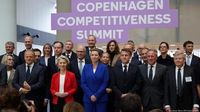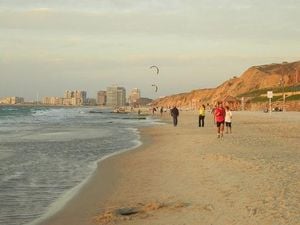On October 1, 2025, the European Commission unveiled a bold new proposal aimed at supporting Ukraine’s defenses against ongoing Russian aggression—without directly seizing frozen Russian state assets. European Commission President Ursula von der Leyen introduced the plan, which would use the interest from approximately $300 billion in frozen Russian sovereign assets as backing for a massive loan to Ukraine. The idea? To provide Kyiv with much-needed military and economic aid, while sidestepping the legal and diplomatic landmines that have stymied previous efforts to confiscate Russian funds outright.
Ever since Vladimir Putin launched his full-scale invasion of Ukraine in February 2022, Western governments have wrestled with how to leverage the vast trove of Russian assets immobilized by sanctions. According to The Times, the West promptly prohibited transactions with the Bank of Russia and the Russian Federation’s Ministry of Finance, effectively freezing around $300 billion in foreign currency and gold reserves. The bulk of these assets are held at Euroclear, the Brussels-based central securities depository. And as the ban endures, the pot keeps growing—annual interest of nearly $3 billion continues to accrue, swelling the total sum even further.
Western leaders, facing the daunting costs of supporting Ukraine’s war effort, have eyed these assets with obvious interest. The United States has so far contributed $135 billion in aid, EU institutions have provided $74.3 billion, and the UK has chipped in $22 billion, according to The Times. With the war grinding on and bills mounting, the temptation to tap into Russia’s frozen wealth has only intensified.
Yet, as The Times notes, the straightforward solution—simply transferring these assets to Ukraine—has proven legally fraught. In 2022, then-EU foreign affairs chief Josep Borrell floated the idea of outright seizure, citing the U.S. precedent of confiscating billions from Afghanistan’s central bank after the Taliban takeover. Russia, for its part, responded with predictable outrage. Deputy Foreign Minister Alexander Gruschko warned that such a move would constitute “complete lawlessness” and threatened retaliation against the EU. The legal basis for seizing sovereign state assets remains contested, tangled in doctrines of sovereign immunity and international investment agreements. Some EU member states have also balked, worried about the precedent such a step might set for global finance.
Amid these hurdles, the European Commission’s new proposal attempts a delicate balancing act. Instead of seizing the assets outright, the plan would provide Ukraine with a €140 billion ($150 billion) interest-free loan, backed by the frozen Russian funds. The money would be replaced with zero-coupon bonds guaranteed by the EU, and—crucially—Kyiv would only be required to repay the loan if and when Russia pays reparations for the damage inflicted by its war. In essence, Russia would end up repaying the loan with its own frozen money, but only if it is held accountable for the costs of its invasion.
This “legally creative” solution, as one EU official described it to The Times, has attracted high-profile support. German Chancellor Friedrich Merz has publicly endorsed the scheme, writing in The Financial Times that the funds should be earmarked solely for military equipment and that a portion should be spent with EU defense industries. Merz’s backing gives the proposal significant political heft, and he has positioned it as a policy that offers something for almost everyone—everyone, that is, except Russia.
But while the plan has its champions, it is far from a done deal. At a summit in Copenhagen on October 1, EU leaders gathered to discuss European security and the merits of the loan proposal. According to The Times, no agreement was reached. Belgium, home to Euroclear and thus the bulk of the frozen assets, has demanded further legal reassurances. France, meanwhile, is wary of the potential financial liabilities the plan might impose on member states, especially as it grapples with its own domestic debt crisis. The European Central Bank has also weighed in, warning that the credibility of the euro could be undermined if the scheme backfires or is perceived as a breach of the rule of law.
These hesitations are not new. The West’s response to Russia’s invasion has often been marked by caution and delay. Chancellor Olaf Scholz’s much-heralded Zeitenwende, or “turning point,” address fizzled as Germany hesitated over supplying main battle tanks to Ukraine. The U.S., Britain, and France were slow to allow Kyiv to strike targets inside Russia. According to The Times, there is a growing sense that every conceivable objection to the Commission’s loan scheme is being aired, perhaps as a way to avoid taking decisive action.
Yet the stakes could hardly be higher. Russia has repeatedly tested NATO’s resolve, with recent incursions into alliance airspace and continued threats against Western interests. As The Times observes, “If Ukraine’s allies cannot agree on a scheme to sequestrate Russian assets, despite Russia’s invasion of Ukraine and the murderous conduct of its military campaign, it will reinforce the impression Putin already has of a coalition which likes to sound resolute and committed but is wavering when it comes to action.”
The legal case for the Commission’s plan is not without merit. International law recognizes the doctrine of countermeasures, which allows states to take certain actions to force compliance with international norms. Proponents argue that using the frozen assets as collateral for a loan—rather than seizing them outright—skirts the thorniest legal issues while still harnessing the funds for Ukraine’s defense and, potentially, its reconstruction. The plan’s structure also means Ukraine would only be on the hook for repayment if Russia is found liable for reparations, a scenario that would likely require a negotiated settlement or international judgment.
For Ukraine, the prospect of up to five years of financial support could be a game-changer. According to The Times and statements from von der Leyen’s office, the initiative is designed to bolster Ukraine’s military resilience, helping it weather Russian aggression and persistent airspace violations. The hope is that by providing predictable, long-term aid, the West can both strengthen Kyiv’s hand on the battlefield and signal its enduring commitment to Ukrainian sovereignty.
Of course, the proposal is not without risks. If the legal arguments for the plan fail to convince skeptical EU members or international courts, the EU could face lawsuits or reputational damage. There is also the ever-present danger of Russian retaliation, whether economic or otherwise. But as the war drags on and the costs of inaction mount, many in Europe are coming to see some form of creative risk-taking as unavoidable.
As discussions continue, the West finds itself at a crossroads. Will it seize the opportunity to put Russia’s frozen wealth to work for Ukraine, or will legal and political caution once again tip the scales toward inaction? The answer may well shape the trajectory of the conflict—and Europe’s own security—for years to come.




